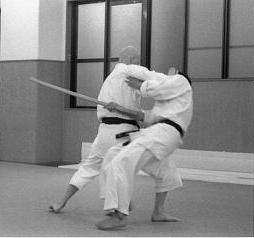Black belt (martial arts)
In East Asian martial arts, the black belt is associated with expertise, but may indicate only competence, depending on the martial art.[1] The use of colored belts is a relatively recent invention dating from the 1880s.[2]

Origin
The systematic use of belt colour to denote rank was first used in Japan by Jigoro Kano, the founder of judo in the 1880s. Previously, Japanese Koryu instructors tended to provide rank certificates only.[3] Initially the wide obi was used. As practitioners trained in a kimono, only white and black obi were used. It was not until the early 1900s, after the introduction of the judogi, that other colours were added.[2] Other martial arts later adopted the custom. This includes martial arts that traditionally did not have a formalised rank structure. This kind of ranking is less common in arts that do not claim a far Eastern origin, though it is used in the Marine Corps Martial Arts Program.
Relative rank

Rank and belts are not equivalent between arts, styles, or even within some organisations.[4] In some arts, a black belt may be awarded in three years or even less, while in others it takes dedicated training of ten years or more. Testing for black belt is commonly more rigorous and more centralised than for lower grades.
Ability
In contrast to the "black belt as master" stereotype, a black belt commonly indicates the wearer is competent in a style's basic technique and principles.[2] Since in many styles a black belt takes three to six years of training to achieve, a possible analogy might be a bachelor's degree: the student has a good understanding of fundamental concepts and ability, but has not yet perfected their skills. In this analogy a graduate degree would represent advancement past the first degree. Brazilian jiu-jitsu would be a notable exception to this, as a black belt for a jiu-jitsu practitioner typically takes 7–12 years of training to earn, and a black belt holder is generally viewed as an expert in the art.
Another way to describe this links to the terms used in Japanese arts; shodan (for a first degree black belt), means literally the first/beginning step, and the next grades, nidan and sandan are each numbered as "ni" is two and "san" is three, meaning second step, third step, etc. The shodan black belt is not the end of training but rather as a beginning to advanced learning: the individual now "knows how to walk" and may thus begin the "journey".
As a "black belt" is commonly viewed as conferring some status, achieving one has been used as a marketing gimmick. For example, a school might guarantee that one will be awarded within a certain period, or for a certain amount of money.[5] Such schools are sometimes referred to as McDojos or belt factories.[6]
Teaching
In some Japanese schools, after obtaining a black belt the student also begins to instruct, and may be referred to as a senpai (senior student) or sensei (teacher). In others, a black belt student should not be called sensei until they are sandan (third degree black belt), or the titles kyosa or sabom in Korean martial arts as second degree or higher, as this denotes a greater degree of experience and a sensei must have this and grasp of what is involved in teaching a martial art.
Higher grades

In Japanese martial arts the further subdivisions of black belt ranks may be linked to dan grades and indicated by 'stripes' on the belt. Yūdansha (roughly translating from Japanese to "person who holds a dan grade") is often used to describe those who hold a black belt rank. While the belt remains black, stripes or other insignia may be added to denote seniority, in some arts, very senior grades will wear differently colored belts.
In judo and some forms of karate, a sixth dan will wear a red and white belt. The red and white belt is often reserved only for ceremonial occasions, and a regular black belt is still worn during training. At 9th or 10th dan some schools award red. In some schools of jujutsu, the shihan rank and higher wear purple belts. These other colors are often still referred to collectively as "black belts".[5][7]
References
- "Myths and Misconceptions Part 1 - Vol 44 No. 1". Black Belt Magazine. Archived from the original on 2014-06-06. Retrieved 2010-01-29.
- Ohlenkamp, Neil (March 25, 2007). "The Judo Rank System". JudoInfo.com. Retrieved 2007-10-15.
- Fumon, Tanaka; Samurai fighting arts: the spirit and the practice, Kodansha International, 2003 ISBN 9784770028983 p25
- Sensei, Brian (August 10, 2018). "Karate Belt Ranks — History and Present". Full Potential Martial Arts, San Diego.
- Pollard, Edward. "Michael Jai White Ignites Black Dynamite". Black Belt Magazine. Archived from the original on 2010-01-02. Retrieved 2009-12-27.
- Cotroneo, Christian. (November 26, 2006) Toronto Star. There are also associations that award higher dan grades for a fee: hence the proliferation of 8th and 9th degree 'grandmasters' in the USA, who have little to support their claim to such titles. .Kicking it up at the McDojo. Section: News; Page A12. Archived October 16, 2007, at the Wayback Machine
- "Becoming A Black Belt". Fight Magazine. Archived from the original on 2011-07-11. Retrieved 2010-01-08.